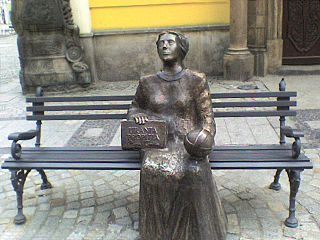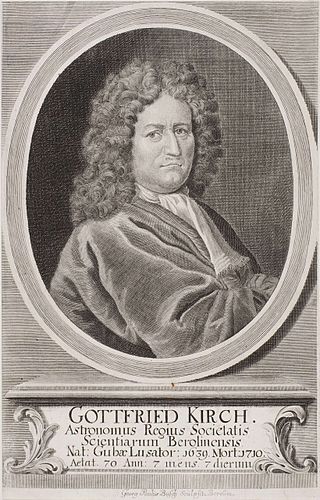Related Research Articles

A Flamsteed designation is a combination of a number and constellation name that uniquely identifies most naked eye stars in the modern constellations visible from southern England. They are named for John Flamsteed who first used them while compiling his Historia Coelestis Britannica.

Johann Elert Bode was a German astronomer known for his reformulation and popularisation of the Titius–Bode law. Bode determined the orbit of Uranus and suggested the planet's name.

Johannes Hevelius was a councillor and mayor of Danzig (Gdańsk), in the Polish–Lithuanian Commonwealth. As an astronomer, he gained a reputation as "the founder of lunar topography", and described ten new constellations, seven of which are still used by astronomers.
The year 1776 in science and technology involved some significant events.
The year 1798 in science and technology involved some significant events.
The year 1687 in science and technology involved some significant events.
The year 1647 in science and technology involved some significant events.
The year 1611 in science and technology involved some significant events.

Philippe de La Hire was a French painter, mathematician, astronomer, and architect. According to Bernard le Bovier de Fontenelle he was an "academy unto himself".

Maria Cunitz or Maria Cunitia was an accomplished Silesian astronomer, and the most notable female astronomer of the early modern era. She authored a book Urania propitia, in which she provided new tables, new ephemera, and a simpler working solution to Kepler's second law for determining the position of a planet on its elliptical path. The Cunitz crater on Venus is named after her. The minor planet 12624 Mariacunitia is named in her honour.

Adrien Auzout [pronounced in French somewhat like o-zoo] was a French astronomer.

Gottfried Kirch was a German astronomer and the first "Astronomer Royal" in Berlin and, as such, director of the nascent Berlin Observatory.

Peter Crüger or Peter Krüger was a mathematician, astronomer, polymath, and teacher of Johannes Hevelius.

Nathanael Matthaeus von Wolf, Nathanael Matthäus von Wolf, Polish: Nataniel Mateusz Wolf was a German botanist, physician, and astronomer.
Maria Margaretha Kirch was a German astronomer. She was one of the first famous astronomers of her period due to her writing on the conjunction of the sun with Saturn, Venus, and Jupiter in 1709 and 1712 respectively.

Elisabeth Catherina Koopmann-Hevelius is considered one of the first female astronomers. Originally from Danzig, Poland, she contributed to improve the work and observations done together with her husband Johannes Hevelius.
Abraham von Franckenberg was a German mystic, author, poet and hymn-writer.

Jeremias Falck was an engraver of the 17th century Baroque, born and active in the Polish–Lithuanian Commonwealth. He signed most of his over 300 works as J. Falck, sculp., a few as Falck Polonus or Falck Gedanensis.

The Academic Gymnasium Danzig was a school founded in Gdańsk, Poland. It was founded in 1558 by Johann Hoppe (1512–1565), who had previously worked at schools in Kulm and Elbing until Catholic Prince-Bishop Stanislaus Hosius closed them. For most of its existence it had a character similar to that of a university.
The Sevenfold Sun Miracle was an atmospheric phenomenon witnessed in Gdańsk in 1661. It was a complex halo phenomenon, and was described by Georg Fehlau, the pastor of the St Marien church, in a sermon two weeks later, which was then published under the title Siebenfältiges Sonnenwunder oder sieben Nebensonnen, so in diesem 1661 Jahr den 20. Februar neuen Stils am Sonntage Sexagesima um 11 Uhr bis nach 12 am Himmel bei uns sind gesehen worden The same event was also described by the astronomer Johan Hevelius the following year in his book Mercurius in Sole visus Gedani.